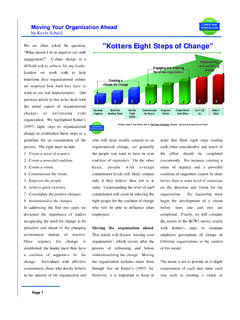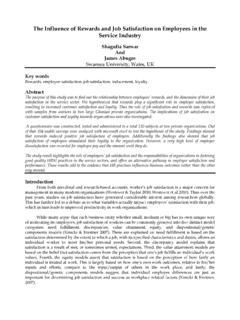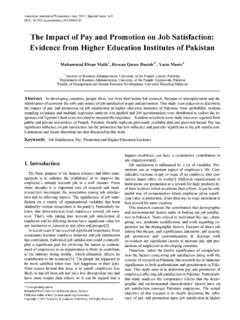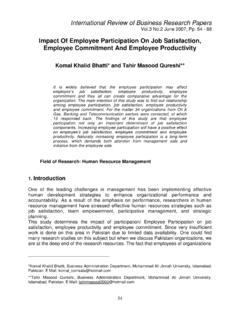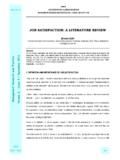Transcription of Job Satisfaction: What is it? Why is it Important? …
1 Page 1 job satisfaction : What is it? Why is it Important? How Can you Get it? by Kevin ScheidThe issue of job satisfaction , what it is and why it is important, brings with it a great deal of research and opinion accompanied by a vast store of written material. However, the topic job satisfaction lacks clarity and is sometimes controversial. The term job satisfaction is understood to mean everything from making all aspects of a job easy for employees to making the job meaningful, significant and challenging. Research on the importance of job satisfaction can be equally confusing with some research clearly indicating no correlation between job satisfaction and job effectiveness while other research indicates there is a definite connection between the two.
2 The likely reason for this confusion, beyond a lack of understanding on the topic, is that all factors associated with job satisfaction are not understood, agreed upon, measured or correlated. Moreover, all the factors contributing to employee motivation and effectiveness are not captured in any one of the single ambiguous concepts of job satisfaction . Thus, much of the qualitative research has not been verified by qualitative data. Research conducted by Schleicher, Watt and Greguras (2004) indicates that individuals with identical responses to questions on job satisfaction often possess entirely different behaviors relating to job performance. Additionally, differing factors relating to job satisfaction hold varying degrees of importance to individuals.
3 Thus, a proven model showing the relationship between job satisfaction and performance has been elusive despite the vast quantity of qualitative data supporting the relationship. These issues are very complex and have simply not been fully deciphered by researchers. Dispositional Theory Some of the theories relating to job satisfaction may further illustrate the complexity of the issue and help the understanding of how management may positively affect job performance through job satisfaction . The first theory is the dispositional theory. The idea that people who are happy in life are happy in their job is called the dispositional theory and there is significant research to support this idea. Heller(2002) connects three behavioral theories to aid in the understanding of the dispostional theory.
4 These three theories include research on positive affectivity and negative affectivity, the big five personality attributes and core self evaluations. Positive affectivety is a personality characteristic described as high energy, enthusiastic and pleasurable engagement while negative affectivety is a personality type characterized as distressed, unpleasurable engagement and nervousness (Heller, 2002). Research has shown that people with positive affectivity are happier in their work and happier in life than those with negative affectivity. The big five personality attributes introduced by Goldberg (1990) have a near consensus agreement from behavioral experts as the comprehensive personality taxonomy.
5 According to Heller (2002) these five traits include: extraversion (or surgency), neuroticism (or emotional instability), agreeableness, conscientiousness, and openness The idea that peo-ple who are happy in life are happy in their job is called the dispositional theory and there is significant re-search to support this idea. Page 2 (or culture). Research has shown a strong correlation between these five factors and job satisfaction . The third facet of dispositional theory, core self evaluation theory, developed by Judge, Locke, and Durham (1997) is gaining acceptance as a model for determining job satisfaction and job performance. Core self evaluation theory has four facets including: self-esteem, generalized self-efficacy, locus of control, and emotional stability (low neuroticism).
6 This theory again links personality attributes and practices with motivation, job satisfaction and job performance. All three dispositional theories recognize the connection between job satisfaction , motivation and performance but focus on the attributes of the person entirely. Thus, the dispositional theory suggests that some people will be satisfied, motivated and high performing at work regardless of how poorly managed while other people will not be happy no matter how great an organization. However, the data indicates that despite the correlation, personality can only explain less than half of the level of job satisfaction . This tells us that there are likely some elements within organizational control which can affect employee job satisfaction .
7 Hygiene Theory Fredrick Hertzberg developed the hygiene theory on job satisfaction and employee motivation which can tie the principles of the disposition theory together with the influence management has on job satisfaction , performance and motivation. According to Herzberg (1974) there are two factors relating to satisfaction and motivation in the workplace; satisfiers and dissatisfiers. Satisfiers relate to the content of the work such as achievement, recognition for achievement, interesting work, increased responsibility, growth, and advancement. Herzberg (1974, p18). Dissatisfiers are related to how employees are treated and include such items as company policy and administration practices, supervision, interpersonal relationships, working conditions, salary, status, and security.
8 Herzberg (1974, p18). If we combine this theory with the disposition theory we can more clearly see a model for job satisfaction in which some satisfaction or dissatisfaction is inherent in the nature of each individual worker, some satisfaction comes from the content of the work and some dissatisfaction comes from the way they are treated. Managers have some influence on the level of satisfaction by fostering achievement, recognizing achievement, making the work interesting, giving employees responsibility and providing for opportunities for growth and advancement. More importantly, managers can create dissatisfaction with inequitable pay, poor company personal policies, working conditions or job security.
9 The importance of each of these job dissatisfiers relates to the frequency it occurs and the intensity of the shortfall. In other words a policy that treats employees poorly every day is a bigger dissatisfier than a policy which treats them poorly only once per month. Moreover, the severity of the dissatisfier affects the importance of that dissatisfier. Therefore, if pay is at such a level that people cannot meet their basic needs, then pay would overshadow all other dissatisfiers and eclipse job satisfiers. How do you improve on job The first step in im-proving job satisfac-tion might be to hire people who are satis-fied with their life. Page 3 satisfaction ? Now that you may have a feel for the complexity of the issue you may better understand how improving job satisfaction in your organization can be an illusive goal.
10 The first step in improving job satisfaction might be to hire people who are satisfied with their life. This step should be fairly easy if you are hiring Christians who are putting Christ at the center of their lives. One school superintendent who led a school certified as a Best Christian Workplace told his staff that he wanted people who wanted to work at the school, liked the kids and were happy with the work. If they were not happy then they owed it to themselves to move on and find a job where they were happy. This might not have been the singular policy making this school a great place to work, but the job satisfaction theories certainly support the idea that this policy would have a significant impact on the overall positive culture of the workplace.
